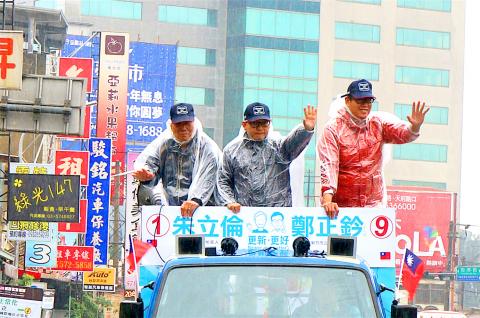Voter turnout for Saturday’s presidential election was the lowest of the six direct presidential elections since 1996, data compiled by the Central Election Commission showed.
Voter turnout in the election was 66.27 percent, compared with 76.04 percent in 1996, 82.7 percent in 2000, 80.28 percent in 2004, 76.33 percent in 2008 and 74.38 percent in 2012, the commission said.
The figures were released alongside the commission’s announcement late on Saturday that Democratic Progressive Party (DPP) Chairperson Tsai Ing-wen (蔡英文) had won the election.

Photo: CNA
Tsai and her running mate, Chen Chien-jen (陳建仁), received 6.89 million votes, or 56.12 percent of total valid votes, commission Chairman Liu Yi-chou (劉義周) said.
Tsai defeated Chinese Nationalist Party (KMT) candidate Eric Chu (朱立倫), who garnered 31.04 percent of the total vote, and People First Party (PFP) candidate James Soong (宋楚瑜), who received 12.84 percent of the vote.
In the legislative race, the DPP won 68 seats out of 113, up from 40 in the previous election four years ago, to give it an absolute majority in the legislature for the first time.
The KMT won 35 seats, sharply down from 64 in the previous election, the commission said.
The New Power Party (NPP) won five seats to become the third-largest party in the Legislative Yuan, followed by the PFP with three seats, the Non-Partisan Solidarity Union with one seat and an independent with the final seat.
The commission said voter turnout in single-member legislative constituency races was 66.58 percent, and 66.25 percent for the political party vote that determined the distribution of legislators-at-large.
Turnout was 57.66 percent for the vote for Aboriginal representatives in mountainous areas and 51.72 percent for the vote for Aboriginal representatives in low-lying areas.
Meanwhile, the commission said that five political parties that have each garnered more than 3.5 percent of the total number of votes cast in legislative elections are eligible to collect NT$50 per vote annually over the next four years, in accordance with the Civil Servants Election and Recall Act (公職人員選舉罷免法).
The New Party, which garnered 4.18 percent of the vote, would also receive subsidies, although it will not hold any legislator-at-large seats.
A record 18 political parties competed in the legislative election and four of them — the DPP, KMT, PFP and NPP — received more than 5 percent of the total votes, making them eligible to be allocated legislator-at-large seats and to receive the election subsidy, commission statistics showed.
It is calculated that the DPP would receive NT$268.54 million (US$7.94 million) each year, given that it garnered more than 5.37 million votes in the legislative election, while the KMT can claim NT$164.04 million and the PFP NT$39.74 million.
The NPP would be eligible to receive NT$37.21 million per year and the New Party NT$25.5 million.

Taiwan is to commence mass production of the Tien Kung (天弓, “Sky Bow”) III, IV and V missiles by the second quarter of this year if the legislature approves the government’s NT$1.25 trillion (US$39.78 billion) special defense budget, an official said yesterday. Commenting on condition of anonymity, a defense official with knowledge of the matter said that the advanced systems are expected to provide crucial capabilities against ballistic and cruise missiles for the proposed “T-Dome,” an advanced, multi-layered air defense network. The Tien Kung III is an air defense missile with a maximum interception altitude of 35km. The Tien Kung IV and V

The disruption of 941 flights in and out of Taiwan due to China’s large-scale military exercises was no accident, but rather the result of a “quasi-blockade” used to simulate creating the air and sea routes needed for an amphibious landing, a military expert said. The disruptions occurred on Tuesday and lasted about 10 hours as China conducted live-fire drills in the Taiwan Strait. The Civil Aviation Administration (CAA) said the exercises affected 857 international flights and 84 domestic flights, affecting more than 100,000 travelers. Su Tzu-yun (蘇紫雲), a research fellow at the government-sponsored Institute for National Defense and Security Research, said the air

A strong continental cold air mass is to bring pollutants to Taiwan from tomorrow, the Ministry of Environment said today, as it issued an “orange” air quality alert for most of the country. All of Taiwan except for Hualien and Taitung counties is to be under an “orange” air quality alert tomorrow, indicating air quality that is unhealthy for sensitive groups. In China, areas from Shandong to Shanghai have been enveloped in haze since Saturday, the ministry said in a news release. Yesterday, hourly concentrations of PM2.5 in these areas ranged from 65 to 160 micrograms per cubic meter (mg/m³), and pollutants were

Taiwan’s armed forces have established response protocols for a wide range of sudden contingencies, including the “Wan Chun Plan” to protect the head of state, the Ministry of Defense (MND) said today. After US President Donald Trump on Saturday launched a series of airstrikes in Venezuela and kidnapped Venezuelan President Nicolas Maduro, concerns have been raised as to whether China would launch a similar “decapitation strike” on Taiwan. The armed forces regularly coordinate with relevant agencies and practice drills to ensure preparedness for a wide range of scenarios, Vice Minister of National Defense Hsu Szu-chien (徐斯儉) told reporters before a